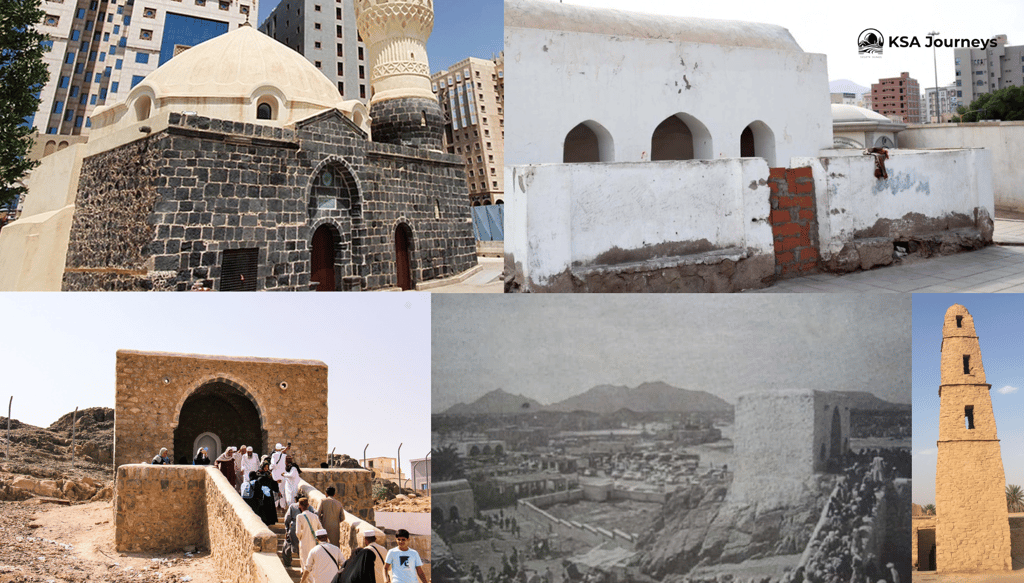A Journey to The Seven Mosques in Medina! 🕌✨
Welcome, fellow travelers and history enthusiasts! Are you ready to embark on a fascinating journey through Medina, the radiant city of Saudi Arabia? If yes, then tighten your seat belts as we dive into the mesmerizing world of The Seven Mosques.
MEDINA
Me
12/10/20237 min read


Exploring the Magnificent Mosques of Madinah, KSA
Hey there, fellow travelers! 🕌 Are you ready to embark on a spiritual and cultural journey to the heart of Madinah, KSA? In this blog, we'll take a captivating tour of the seven iconic mosques that hold great historical and religious significance. From the rich history to practical tips for visitors, this guide is your ultimate companion for experiencing the beauty and serenity of these sacred sites. So, let's dive in and discover the treasures that await you in the City of the Prophet! 🌟
Unveiling the History 📜
Madinah, also known as the "City of the Prophet," is home to several breathtaking mosques that have stood the test of time. The history of these mosques is deeply intertwined with the life of Prophet Muhammad and the early days of Islam. Each mosque has its own unique story and architectural splendor, making them a must-visit for anyone seeking a profound spiritual and cultural experience.
The seven mosques:
1. Al-Fath Mosque
Al-Fath Mosque, also known as Al-Ahzab Mosque, is one of the historic Seven Mosques located in Medina, Saudi Arabia. The mosque is situated atop a small cliff and is known for its significance in Islamic history. It is narrated that the Prophet Muhammad prayed at this mosque during the Battle of the Trench, and the battle ended in a Muslim victory. The mosque was built during the time of Caliph Umar bin Abdul Aziz and renovated by the minister Saifuddin Abu al-Hija in 1154.
The Al-Fath Mosque is the largest of the Seven Mosques and is located beneath Mount Sala' on the western part. It was constructed between 705 and 711 and refurbished in 1179. The mosque has a small size, which indicates a sparse population in the region during the time of the Prophet. A striking feature of the mosques is their utilitarian design and lack of adornment.
Visitors to the Al-Fath Mosque often leave their names and prayers for family and friends on the entrance wall, although Saudi authorities discourage this practice. The mosque is not only significant for its historical value but also for its architectural characteristics, which are similar to those of other mosques in the area, such as the Salman Al-Farisi Mosque.
2.The Salman Al-Farsi Mosque
The Salman Al-Farsi Mosque is a historic mosque located in the city of Salman Pak, Al-Mada'in district, Iraq. It is a significant site as it contains the purported tomb of Salman al-Farsi, a companion of the Prophet Muhammad and the first Persian who converted to Islam. The mosque is historically a Sunni mosque, but it is now affiliated with the Shi'a sect. It was established over the mausoleum with funding from the Iraqi government. The mosque is visited for the sacred tombs within it and also holds Qur'anic memorization courses and classes to study the Quran. Salman al-Farsi, also known as Salman the Persian, was a companion of the Prophet Muhammad and the first Persian who converted to Islam. He played an important role in the struggles of the growing Muslim state and was known for his innovative military strategies, such as suggesting the digging of a trench around Madinah to defend against the Quraish.
3.The Abu Bakr Al-Siddiq Mosque
The Abu Bakr Al-Siddiq Mosque is one of the oldest mosques in Medina, Saudi Arabia. It is located towards the southwest side of Al-Masjid an-Nabawi and is separated from Al-Ghamama Mosque by the main road. The mosque was built for the first time in the Princedom of Omar Bin Abdul Aziz in Medina and was renovated by the Ottoman Sultan Mahmoud II in 1838 CE. The mosque is square-shaped, with the length of its side being nine meters. It was built with black basalt stones and was painted white from inside with a dome above it whose height is 12 meters. It has a rectangular courtyard whose length is 13 meters and width is 6 meters, and a minaret which is 15 meters high. The small mosque has one dome and one minaret has a single and very ornate dome. According to tradition, Muhammad used to offer Eid prayers at this site, and Abu Bakr continued the tradition during his Caliphate, so it was attributed to him.
4.Umar bin Khattab Mosque
The Umar bin Khattab Mosque, also known as the Mosque of Umar Ibn al-Khattab, is a historic mosque located in Dumat al-Jandal in northern Saudi Arabia. It is attributed to the caliph Umar Ibn al-Khattab and is said to have been built by him in the year 16 AH (638 AD) while he was heading to Jerusalem. The mosque is known for its almost rectangular shape, built of carved stone, and its design is reminiscent of the early stages of the Prophet's Mosque in Medina. It consists of the corridor of the qiblah, the mihrab, the minbar, the courtyard, and the prayer area. The mosque's architecture represents the continuity of the pattern of the design of the first mosques, particularly the design of the Prophet’s Mosque in Medina in its early stages. The existing building appears to have been built in a much later period, casting doubt upon its attribution to the Rashidun Caliph Umar Ibn al-Khattab. The mosque is a historical landmark and a significant site for pilgrims, representing an important part of Islamic history and architecture.
5.Sa'd bin Mu'adh Mosque
Sa'd bin Mu'adh Mosque in Medina is not widely documented in the available sources. However, Sa'd bin Mu'adh, after whom the mosque is likely named, was a prominent figure in Islamic history. He was the chief of the Aws tribe in Medina and a close companion of the Prophet Muhammad. Sa'd bin Mu'adh is highly respected in Islam for his contributions and sacrifices for the faith. The mosque named after him is likely a tribute to his legacy and is a place of significance for the Muslim community, particularly those who admire the companions of the Prophet. While specific details about the mosque are not readily available, its association with Sa'd bin Mu'adh reflects the reverence and honor accorded to him in Islamic tradition.
6.Ali bin Abu Talib Mosque
Ali ibn Abi Talib Mosque, located in the area of the Seven Mosques in Medina, is a significant destination for visitors seeking to explore Islamic cultural heritage. Ali ibn Abi Talib (601-661 CE) was the cousin and son-in-law of the Islamic Prophet Muhammad and the fourth Caliph of Islam from 656 to 661. The mosque is associated with Ali's legacy, who was a prominent figure in Islamic history. He was known for his close relationship with the Prophet, his wisdom, and his valor in battle. The mosque holds historical importance as a place linked to Ali's leadership and the early days of Islam. It stands as a symbol of the rich Islamic heritage and the legacy of Ali ibn Abi Talib in the city of Medina.
7.Fatimah Az-Zahra Mosque
Fatimah Az-Zahra Mosque is a small mosque located in the Seven Mosques complex in Medina, Saudi Arabia. It has an area of 4x3 meters and was built during the Ottoman period of the Hejaz Vilayet. Although there are no accounts in the order from the Islamic prophet Muhammad or in the Quran about this mosque, it is often visited by pilgrims. The local government of Medina is currently renovating the mosque while maintaining its original shape and building a large park surrounding it as a decoration of the small building.
In Conclusion 🌍
As you prepare for your pilgrimage to the enchanting city of Madinah, immerse yourself in the timeless beauty and profound history of these seven mosques. Embrace the spiritual aura, admire the architectural marvels, and allow the legacy of Islam to captivate your heart and soul. Your journey to the City of the Prophet promises to be a transformative and unforgettable odyssey. Safe travels, and may your visit be blessed with peace and enlightenment! 🌺
FAQs
1. What are the Seven Mosques in Medina?
The Seven Mosques are a group of historically significant mosques in Medina, Saudi Arabia, that hold great religious importance and are connected to the life of Prophet Muhammad and the early days of Islam.
2. What is the historical significance of Al-Fath Mosque?
Al-Fath Mosque, also known as Al-Ahzab Mosque, is historically significant for its connection to the Battle of the Trench, where Prophet Muhammad prayed and celebrated a Muslim victory.
3. Who is honored at Salman Al-Farsi Mosque?
Salman Al-Farsi Mosque honors Salman al-Farsi, a close companion of the Prophet and the first Persian to convert to Islam. It is also known for hosting Qur’anic memorization classes.
4. Where is Abu Bakr Al-Siddiq Mosque located?
Abu Bakr Al-Siddiq Mosque is located near Al-Masjid an-Nabawi and is one of the oldest mosques in Medina. It was built using black basalt stones and renovated during the Ottoman era.
5. What is the significance of Umar bin Khattab Mosque?
Umar bin Khattab Mosque, attributed to Caliph Umar Ibn al-Khattab, is a significant site for pilgrims and reflects the architectural style of early mosques, despite being a later construction.
6. Why is Sa’d bin Mu’adh Mosque important?
Sa’d bin Mu’adh Mosque is named after a prominent companion of the Prophet and honors his legacy in Islamic history, even though specific historical details about the mosque are scarce.
7. What does Ali bin Abu Talib Mosque symbolize?
Ali bin Abu Talib Mosque celebrates the legacy of Ali ibn Abi Talib, the Prophet’s cousin and son-in-law, and is a symbol of Islamic heritage linked to the early days of Islam.
8. What can you tell me about Fatimah Az-Zahra Mosque?
Fatimah Az-Zahra Mosque is a small mosque built during the Ottoman period and is currently undergoing renovations. It remains a popular pilgrimage site despite lacking extensive historical accounts.
9. What should visitors expect when touring the Seven Mosques?
Visitors can expect to immerse themselves in the spiritual aura, admire the architectural beauty, and learn about the profound history connected to each mosque.
10. What is the best way to experience the Seven Mosques?
The best way to experience the Seven Mosques is to take your time exploring each site, reflecting on their historical significance, and allowing the spiritual atmosphere of Medina to enhance your journey.
Links
Socials
Subscribe to our newsletter


KSA Journeys is dedicated to showcasing the very best of Saudi Arabia’s destinations from its awe-inspiring natural landscapes to its rich cultural heritage. Our mission is to provide travelers with an easy, enjoyable, and immersive experience as they explore the Kingdom’s most iconic sites, hidden gems, and spiritual landmarks. Whether you're seeking adventure, relaxation, or cultural discovery, KSA Journeys is your trusted companion for unforgettable travel in Saudi Arabia.
Use full Links
Contact Us



